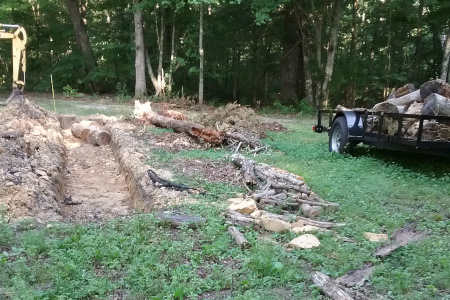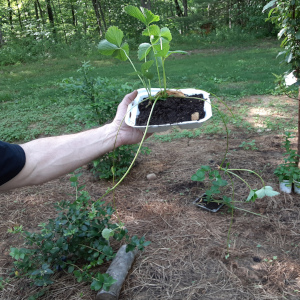Regular readers may recall that we are very into using hugelkultur mounds, in which wood is buried under a planting mound to supply nutrients as the wood rots, store water in the mound like a sponge, and to keep the soil in the mound aerated as the wood mass shrinks over time. In the fall of 2019, we put in a hugelkultur mound for strawberries. Here is a shot of that mound under construction, wood on the trailer on the right winds up in the trench, subsequently covered by the dirt pile on the left:
Afterward, we moved about 40 strawberry plants onto that mound, which now extends an additional length into the foreground, as viewed in the above picture.
This year, our guinea birds ate most of the strawberry blossoms as they were emerging. In response, the strawberry plants appear to have gone into emergency propagation mode, sending out four to six runners per plant, with some of those being secondary and tertiary runners. Below is a shot of an early step in this runner explosion:
The above picture shows the nature of these strawberry runners as binary counters. From the original plant on the right, the first node encountered is a small leaf node, followed by a root node (I’m sure there are official names for these entities, but these are fun software-related names, so I ran with them, pun intended). The first root node on this runner has started taking root in a scrap plastic tray with some holes in the bottom. This tray, ironically, is a lid to a container in which ripe strawberries were packed. The holes were already there for ventilation. I put a little bit of native soil in the bottom, with some mushroom compost in the top (we brought in a ton of compost for various purposes for about $25 dollars earlier that year, most of it is still in a big pile). To the left of the planter, another leaf node can be seen, with a second root node at the far left. All I did with the root node was put it in contact with the soil, hold it in place with a couple of rocks, and mound a little bit of compost around the node. Other than keeping it watered, the root node did all the work. Trial-and-error showed that the leaf nodes do not sprout new plants, so there is that.
After a few weeks, and some torrential rains encouraging even more prolific runners, we simply ran out of adhoc planters such as milk jug halves, styrofoam trays of all kinds, plastic lids and containers like the above. If we could keep up with the explosion, we would have about a thousand plants in less than two years, or probably sooner as the propagation does not appear to have abated much. Apparently, strawberries love eating dead wood.
After about three to four weeks of rooting, some of these planters are ready for transplanting, as shown in the below pic:
If you open the larger pic, you can see that this plant complex has three runners of its own, with two of those already showing early roots. This container, by the way, is a lid of a takeout tray with some holes punched in the now-bottom. The aggressive root network of a similar planter can be seen below:
All of the new plants in this condition have thrived very well in their new homes on a new mound to the side of the original mound. Hopefully, with some fences in place to keep the bird team at bay, we can begin experimenting with home-grown strawberry wine this time next year, suitable for preserving the nutrients into the winter.




Leave a Reply
7 Comments on "Strawberry Runner Explosion"
Wine for nutritive effects. I’ll have to remember that one!
lol. Fermentation is a gift of the gods. Which is why oligarchs seek to control that, and distillation, also.
A comment from Knuckledraggin’ (https://ogdaa.blogspot.com/2020/06/strawberry-runner-explosion-stm.html) on this article states:
“‘Traditional’ hügelkultur lays the wood/logs horizontally; a variation which might be better is standing the logs vertically so roots can tap into the capillaries of the log.
https://lowcostvegetablegarden.blogspot.com/2012/07/vertical-hugelkultur-eliminates-wilt.html
lil jack”
That is a great comment. In swampy rural Georgia, standing the logs vertically also had the benefit of keeping the roots out of bog. Up here on the Cumberland Plateau, we tried that with our first mound. The first year it did great, but we’re going to have to rework it this fall because in this environment the slow-rotting vertical spires within the wood grain are holding the soil too high above the collapsing remainder, leaving large, unhealthy voids in the mound.
We’ve tried to get the benefit of the capillaries by also sprinkling in a significant amount of smaller logs and branch and bark giblets to allow lots of rooting surface area within the mound on top of horizontal logs.
Is are there particular kinds of wood to favor or avoid?
Good question, Nemo. We’ve used all kinds of wood with success. I think an important element is to have a mix of green and rot. The idea is that you don’t want the entire mass to “mature” at the same time. So, a bunch of chips would be bad, as they would all want to rot at the same time, but mixing in chips with logs and smaller branches would be good. A mix of hardwood and softwood has the same effect to spread out the maturation over a longer time. We’ve also spiked the mounds during construction with a few gallons of urine and wood ashes from a few open fires, as well as lots of bird droppings, to help overcome the nutrient deficit that can come from the first year of rotting.
We also only use natural wood, no construction scraps. Pressure treated, especially old arsenic-based treatments are especially bad, but any pressure treated will tend to kill or retard the biological action even if it doesn’t poison you via the food grown. Old painted wood can have lead, of course, and even some non-pressure-treated dimensional lumber can have coatings that probably aren’t a good thing for the mound. So we avoid construction scraps entirely to not have to worry about it. An obvious exception of course would be your own sawmill scraps.
Hi Tom!
There’s more info on Hugelkultur on the permies and richsoil websites. Best I remember, green cedar and green pine were not recommended, but to wait until the sap/resin had left the logs. But I defer to your experience.
Black Walnut shells, bark and wood chips were not recommended due to the toxic juglone substance which inhibits other plant growth. Black Locust is too dense and takes a loooong time to decompose, which is why many farmers used it for fence posts. It blew my mind when you linked my comment from knuckledraggin. ‘lil jack’
Thanks, Trin!